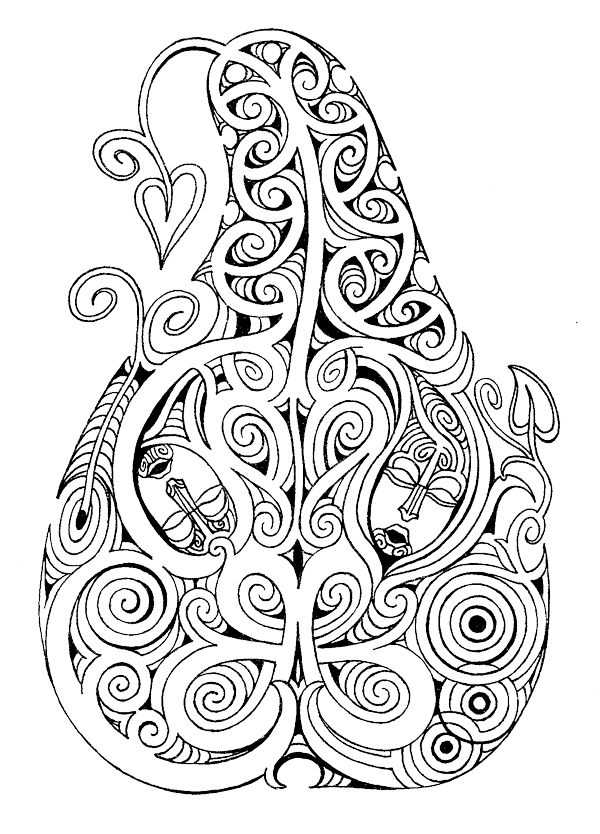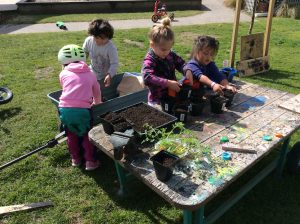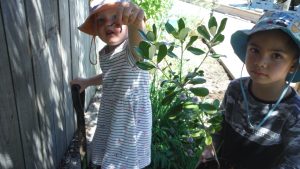
Hinepūtehue associated with gourds, harnessing the air/ wind to create healing, soothing sounds.
Environmental education is becoming increasingly significant in early childhood education. At Paraone we understand the importance of integrating kaupapa Māori theoretical perspectives. We apply frameworks such as; Te Ara Whakamana – a mana enhancement model, Maramataka Māori – Te Tai Ao Māori environmental calendar, Te Wheke – a celebration of ancient teachings and wisdom, Whare Tapa Wha – a Māori perspective on hauora and place based / localised curriculum to support tamariki to connect their worlds in ways that are inclusive of Māori values, practices and knowledge. These practices encourage tamariki, their whānau and the kaiako to be kaitiaki of their worlds.

Tamariki pot up seedlings and sow seeds.
In our journey we have moved from looking at tangible practices like recycling, repurposing, re-using, and gardening as these are now a natural part of our daily routines and rituals. We are deepening our practices and belief systems by placing an emphasis on intangible concepts such as an ethos of care and by having a spiritual connection to Papatūānuku. We do this through a Kaupapa Māori lens and working with the Atuatanga, pūrākau and pakiwaitara.
We strive to provide indigenous experiences that enable tamariki to connect to their worlds in ways that encompass Māori values with experiences that lead tamariki to be environmentally literate.
The tamariki and kaiako connect to having a relationship with Papatūānuku through the use of the environment as a third teacher and having these experiences to explore their learning of Atuatanga. Our curriculum Te Whāriki recognizes the importance of educators providing a culturally relevant curriculum with familiar stories of the living world, pūrākau, and significant knowledge of their place.
There is a definite commitment from kaiako to teach in a way that naturally incorporates Māori values of kaitiakitanga. This is evident through the responsiveness and articulation shared by tamariki and the embedding of te ao Māori in all that they do.
This kindergarten is responsive to implementing education for sustainability by starting locally. The problems of the world can seem insurmountable, however, when a localised curriculum is culturally safe and relevant, we begin to see changes in behaviour and attitudes as tamariki connect on different levels to being Kaitiaki of their worlds.
‘POIPOIA TE KAKANO KIA PUAWAI – Nurture the seed and it will blossom’

Many hands make potting up fun.
One of our projects we have been focusing on for the past 3 years encompasses various concepts and ideas that have been co-constructed with our past and current families is the development of a ‘nature discovery area’. Part of that project has involved building a large raised vegetable garden, purchasing plants, constructing a boardwalk, and establishing a rongoa maara. The rongoa maara consists mostly natives. However, at a recent professional learning workshop about rongoa Māori we learnt how indigenous plant and non-indigenous plants can be used for rongoa. It is about how you prepare and use them. There is so much to learn and Paraone is on that journey. We are strengthening children’s connections with te taiao, seeking whānau advice and guidance about rongoa Māori and gathering the voices and advice of our local iwi. Our projects are supported by the three iwi that we encompass consisting of Ngati Tuwharetoa, Ngati Maniapoto, and Ngati Haua. A local kuia also works with the Kaiako and the tamariki for ensuring cultural knowledges’ or Māori perspectives are included in our curriculum and approach with our tamariki. We feel very blessed to have Nan with our whānau at Paraone.

The maara rongoa creates a living landscape.
This year the kindergarten became an Enviroschool and have attained Bronze level. Two Kaiako Ally Te Wano and Rochelle Faire attended a professional learning and development workshop in Rotorua run by Central Kids and supported by Toimata Foundation. The workshop was really useful and affirmed the mahi that is being embedded at Central Kids Paraone. The kaiako are very grateful to be a part of this kaupapa and learning journey. They are deepening their Mātauranga and further establishing their nature and discovery areas in the outdoors. By designing the curriculum with the Enviroschools principles in mind the kindergarten is in a unique position to be leaders and role models in our community and to change the current discourse of what learning is.
As Paraone move forward into 2021 we aim to sustain our environment through the continued planting of in our rongoa maara.

The rongoa garden is a habitat for the children of Ranginui and Papatūānuku.
Paraone also has a plan to sustain our teaching practice and knowledge as well by planning for a team member to attend the facilitator training provided by Toimata Foundation at Te Mauri Tau. This way the team member can return and not only share with our team but also the other two Central Kids services in Taumarunui. Central Kids Paraone will continue to source mature native trees, putting in water irrigation, and a water catchment system. This is going to support robust discussions with tamariki and whānau about water use and conservation.
Mauriora!
Banner image: planting korokia which can be used for a sore puku next to our kawakawa plants, and kowhai, which is planted by the kopakopa, which can be made into skin balms and we feed it to our rabbit ‘Sammy’. This is a natural immunity booster for him.
